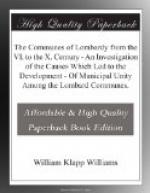A descendant of Charlemagne may have granted to some monastery or bishopric a greater alleviation of some of the fiscal burdens borne by it under his immediate predecessor, but a successor of Berenger when he granted a privilegium did not simply perform the negative benefit of alleviating burdens; he endowed the head of the bishopric—probably in return for some service he had received at his hands or expected to receive—with the positive benefit of the political headship and possession of some city or district of a former count. I mean by this that the earlier immunities—and in these are included all given during the period we are discussing—were all of them what are termed simple or ordinary immunities; that is, those which deal with exemption—whether from burdens for which the receivers would otherwise be liable, or from jurisdiction to which they would otherwise have been subjected—of what may properly be called the private possessions of the churches concerned. They had nothing to do with the privileges of a later time, by which a power to exact burdens was granted and a positive jurisdiction over others allowed: that is, public functions bestowed rather than private rights conceded.
That a distinction of such a character was a difference of kind and not of degree is so plainly apparent that it is unnecessary to dwell longer upon it, and it only remains for us to consider briefly the chronology of some of the changes that took place. If we adhere strictly to the proper signification of the terms used, the development can be somewhat succinctly described by the simple enumeration of the three characteristic features of its progress, viz. protection, exemption, privilege that is jurisdiction or temporal power; and the three periods which are covered respectively by the prominence of these ideas can be roughly stated to be: for the first, the reigns of Charlemagne




